Have you noticed a sudden change in your cat’s behavior towards your dog? It can be concerning and puzzling to see your usually friendly feline acting aggressively towards their four-legged companion. But fear not, there are reasons behind this sudden aggression, and with a little understanding and patience, you can help restore harmony in your household.
Aggression between cats and dogs is not uncommon, and it can be especially prevalent when a shelter cat is introduced into a new home. There are several underlying causes for a cat’s aggressive behavior towards a dog, including fear aggression, redirected aggression, territorial aggression, aggression due to overstimulation, predatory aggression, and unprovoked aggression. It is important to understand these causes in order to address the issue effectively and ensure the well-being of both your pets.
Key Takeaways:
- Aggression between cats and dogs is not uncommon, and there are several underlying causes.
- Cat aggressions can be triggered by fear, territorial disputes, overstimulation, redirected aggression, and underlying medical issues.
- Managing play aggression, fear aggression, redirected aggression, territorial aggression, overstimulation, and predatory aggression requires specific strategies.
- Creating a safe environment and seeking professional help when necessary are crucial in managing aggression.
- Patience and consistency are key in promoting peace between your cat and dog.
Understanding Types of Aggression in Cats
Cats can exhibit various types of aggression, each with its own triggers and characteristics. It is important to recognize and understand these types of aggression in order to address them effectively and promote a harmonious environment for your cat and dog.
Fear aggression: This occurs when a cat reacts aggressively due to feeling threatened. It may exhibit defensive behaviors such as hissing, growling, and swatting.
Redirected aggression: If a cat is unable to respond directly to a perceived threat, it may redirect its aggression towards another target, such as a dog. This type of aggression can be triggered by loud noises, outdoor animals, or other stimuli.
Territorial aggression: Cats may display territorial aggression when a new pet is introduced into the home. The resident cat may try to establish dominance and protect its territory, leading to aggressive behaviors.
Aggression due to overstimulation: Cats have a natural hunting instinct, and intense play sessions can sometimes lead to overstimulation. This can result in aggression towards other family members, including dogs.
Predatory aggression: Cats’ predatory instincts may be directed towards other pets, such as dogs, if they don’t have access to appropriate prey. They may display hunting behaviors like stalking, pouncing, and biting.
Unprovoked aggression: While rare, some cats may exhibit unprovoked aggression without an apparent trigger. This type of aggression may be due to underlying medical causes or pain and should be addressed by a veterinarian.
To effectively manage and address cat aggression, it is important to identify the specific type of aggression your cat is displaying. This will help you implement appropriate strategies and interventions to promote a peaceful coexistence between your cat and dog.
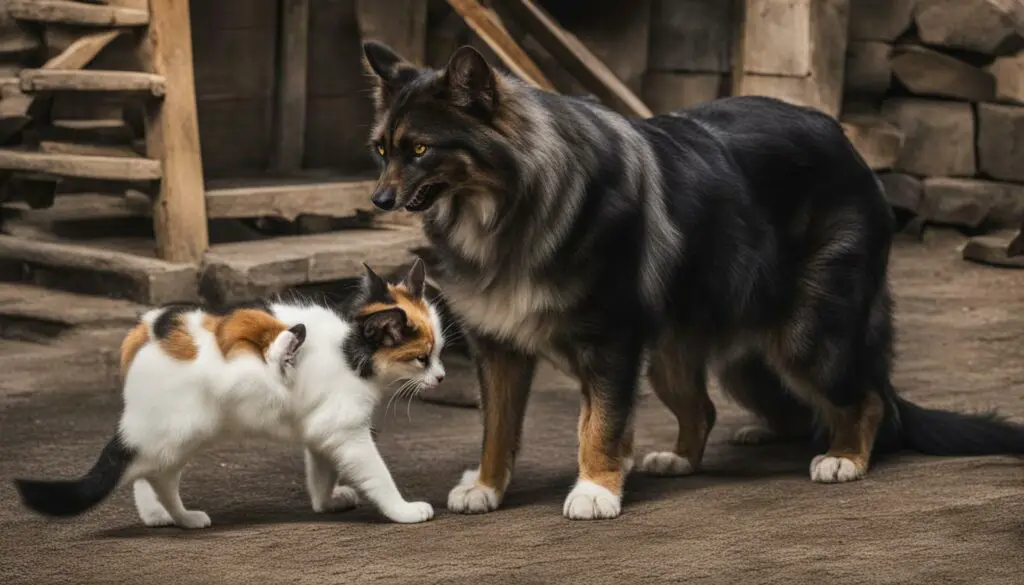
Possible Causes of Sudden Aggression in Cats
Understanding why a cat suddenly becomes aggressive towards a dog can be a challenging task. There are several possible causes that may contribute to this sudden change in behavior. It is important to identify these causes in order to address the aggression effectively and restore harmony between your cat and dog.
One possible cause of sudden aggression in cats is feeling threatened. Cats are instinctively territorial animals, and introducing a new dog into their environment can trigger feelings of insecurity and fear. This fear aggression can manifest as aggressive behavior towards the dog as a means of self-defense.
Another possible cause of sudden aggression is redirected aggression. This occurs when a cat is unable to directly respond to a perceived threat and redirects their aggression towards another target, such as a dog. For example, if a cat sees an outdoor animal through a window and becomes agitated, they may redirect their aggression towards the dog instead.
Sudden aggression in cats can also be a result of overstimulation. Cats have a threshold for how much stimulation they can handle before becoming overwhelmed. If play sessions with the dog become too intense or rough, the cat may respond with aggression. Additionally, changes in the cat’s environment or increased stress factors can also contribute to sudden aggression.
| Possible Causes of Sudden Aggression in Cats |
|---|
| Feeling threatened |
| Redirected aggression |
| Overstimulation |
| Changes in environment or stress factors |
Understanding the possible causes of sudden aggression in cats is an important step in managing and addressing this behavior. By identifying the specific cause, you can implement appropriate strategies to reduce aggression and promote a peaceful coexistence between your cat and dog.
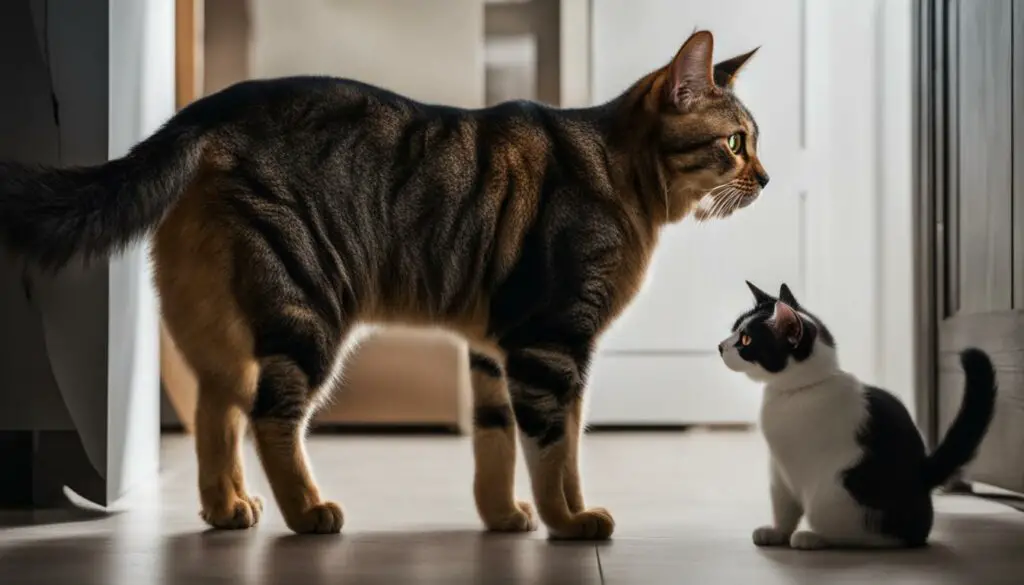
Dealing with Play Aggression
Play aggression is a common behavior in cats, characterized by biting, scratching, and pouncing during play sessions. While it may be normal for cats to exhibit this behavior during play, it is important to establish boundaries and redirect their aggression towards appropriate toys or play objects. Here are some tips for managing play aggression in cats:
- Provide plenty of interactive toys: Engaging your cat in play with appropriate toys can help redirect their aggression. Use toys that allow them to satisfy their hunting instincts, such as interactive wands or puzzle toys.
- Use positive reinforcement: Reward your cat with treats or praise when they exhibit calm and non-aggressive behavior during play. This will help them associate positive experiences with appropriate play behavior.
- Provide alternative outlets for play: Make sure your cat has access to scratching posts, climbing trees, and other play structures. This will help them release their energy and redirect their aggression towards these objects instead of your dog.
It is important to note that play aggression should not be encouraged or tolerated when it becomes excessive or harmful. If your cat’s play aggression is causing harm to your dog or other pets, it is advisable to seek professional help from a veterinarian or animal behaviorist who can provide tailored guidance and solutions for managing the aggression.
Remember, managing play aggression requires consistency and patience. By providing appropriate outlets for play, setting boundaries, and rewarding positive behavior, you can help redirect your cat’s aggression and promote a harmonious relationship between your cat and dog.
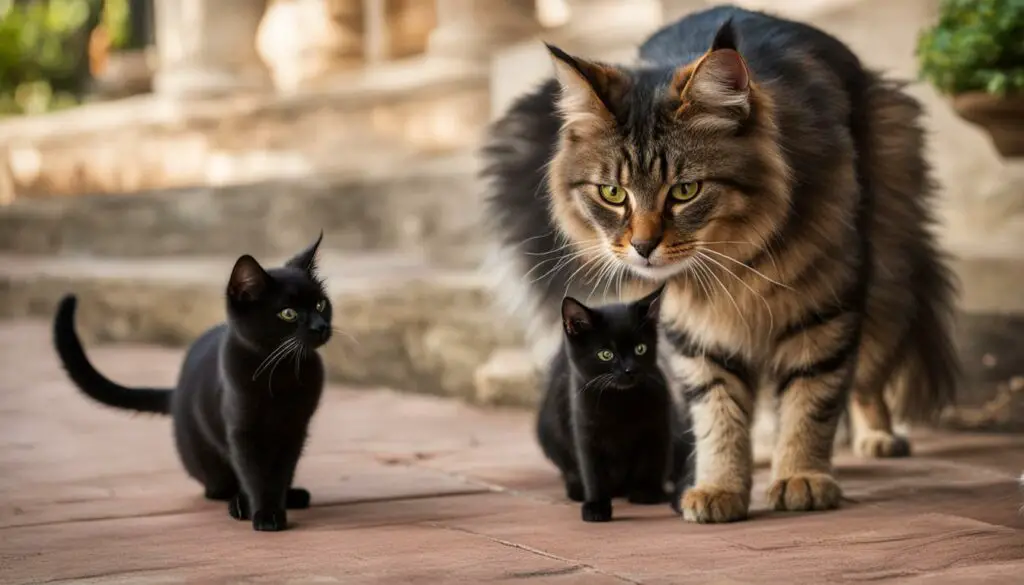
Play Aggression Management Techniques
When dealing with play aggression in cats, it can be helpful to employ specific techniques to manage and reduce aggressive behavior. Here are some additional strategies you can try:
- Use noise deterrents: Clapping your hands or using a noise-making device when your cat becomes too aggressive can help interrupt their behavior and redirect their attention.
- Practice gradual desensitization: If your cat tends to become overstimulated during play, gradually expose them to longer play sessions over time. This can help them build tolerance and reduce the likelihood of aggressive outbursts.
- Seek professional help: If you are having difficulty managing your cat’s play aggression, consider consulting with a veterinarian or animal behaviorist who specializes in cat behavior. They can provide personalized guidance and develop a tailored behavior modification plan.
By implementing these techniques and seeking professional help when needed, you can effectively manage and reduce play aggression in your cat, ensuring a safer and more enjoyable environment for both your cat and dog.
Addressing Fear Aggression
Fear aggression in cats can be a challenging behavior to manage, but with the right approach, it is possible to help your cat feel more secure and reduce aggressive responses towards your dog.
Understanding Fear Aggression
Fear aggression occurs when a cat feels threatened or unsafe, and reacts defensively towards perceived threats, such as a dog. It is important to remember that fear aggression is a result of fear and anxiety, rather than a desire to be aggressive. Cats may display dilated pupils, hissing, growling, or even swatting and biting when they feel afraid.
To address fear aggression, it is essential to create a safe and calming environment for your cat. Providing a designated safe space equipped with hiding spots, such as a cat tree or a cozy hiding box, can give your cat a retreat when they feel overwhelmed. Additionally, using positive reinforcement methods, such as treats and praise, can help build positive associations and gradually desensitize your cat to the presence of your dog.
Managing Fear Aggression
Gradual introductions and controlled interactions between your cat and dog are crucial in managing fear aggression. Start by allowing them to smell each other’s scent through a closed door or a baby gate. Gradually progress to short and supervised face-to-face interactions, rewarding calm and non-aggressive behavior with treats and praise. If your cat becomes fearful or aggressive, it is important to separate them and try again later.
Consulting with a professional, such as a veterinarian or animal behaviorist, can also provide valuable guidance and support in managing fear aggression. They can assess the situation and develop a tailored behavior modification plan to help your cat feel more secure and reduce their aggressive responses towards your dog.
| Managing Fear Aggression: | Key Points: |
|---|---|
| Create a safe space | Provide hiding spots and a designated retreat for your cat |
| Use positive reinforcement | Reward calm behavior and gradually desensitize your cat to the presence of your dog |
| Gradual introductions | Start with scent exchanges and progress to supervised face-to-face interactions |
| Seek professional help | Consult with a veterinarian or animal behaviorist for tailored guidance and support |
Remember, managing fear aggression requires patience and consistency. With time, effort, and the right approach, you can help your cat feel more at ease and promote a harmonious relationship between your cat and dog.
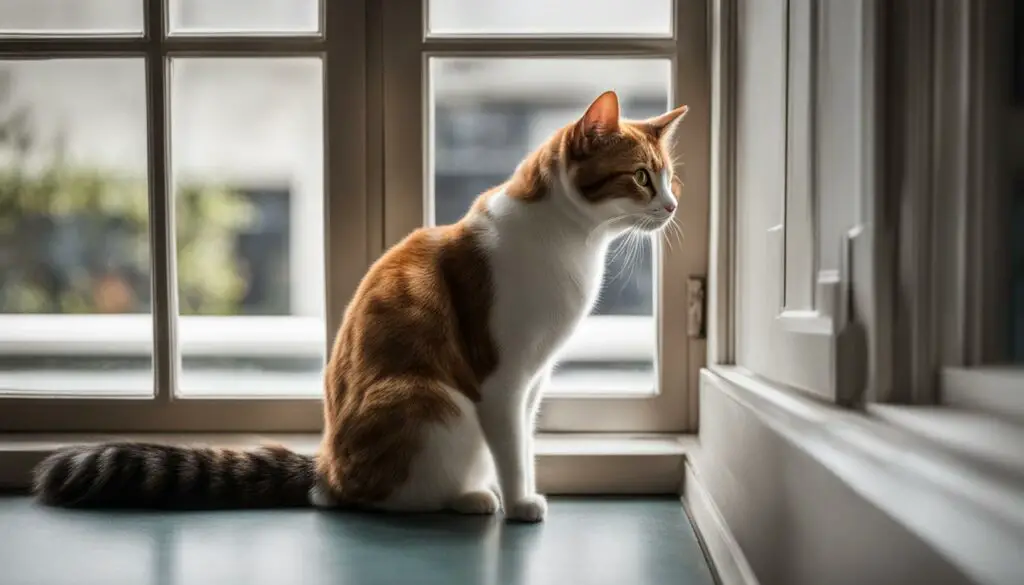
Managing Redirected Aggression
Redirected aggression can be a challenging behavior to address in cats. It occurs when a cat is unable to directly respond to a perceived threat and redirects its aggression towards another target, such as a dog. Dealing with redirected aggression requires identifying and removing the triggers, as well as implementing management strategies to prevent future incidents.
One way to manage redirected aggression is by identifying and eliminating the stimuli that trigger the aggressive behavior. This could include loud noises, outdoor animals, or other environmental factors that may cause the cat to feel threatened. By minimizing or avoiding these triggers, you can reduce the likelihood of redirected aggression occurring.
Separating the cat from the trigger is another effective strategy in managing redirected aggression. If you notice signs of aggression building up, such as growling or hissing, it’s important to provide a safe space for the cat to calm down. This can be a separate room or area where the cat can retreat to until it feels more relaxed.
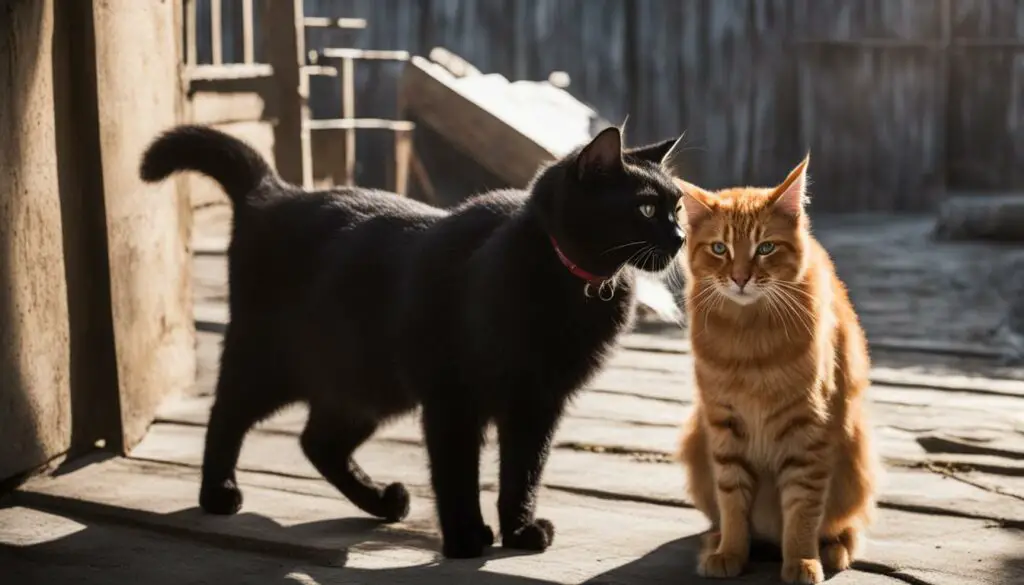
In some cases, using noise deterrents can help interrupt the aggressive behavior and redirect the cat’s attention. This can be achieved by making a loud noise, such as clapping your hands or using a whistle, to startle the cat and break the aggression cycle. However, it’s important to remember that noise deterrents should be used sparingly and as a last resort, as they may cause stress or fear in the cat.
Dealing with redirected aggression requires patience, consistency, and a proactive approach. By identifying and addressing the triggers, creating a safe space for the cat, and using appropriate management techniques, you can help reduce redirected aggression and promote a more peaceful environment for both your cat and dog.
Handling Territorial Aggression
Dealing with territorial aggression in cats can be challenging, but with the right approach, it is possible to manage and reduce this behavior. When a new pet is introduced into the home, the resident cat may feel the need to establish dominance and protect its territory, leading to aggressive behavior. To address territorial aggression:
- Introduce new pets slowly: Gradual integration is key to minimize stress and aggression. Keep the new pet in a separate room and gradually introduce scent swapping and supervised face-to-face interactions.
- Create separate spaces: Each pet should have their own territory where they can feel safe and secure. Provide separate feeding areas, litter boxes, and resting spots for each pet.
- Use positive reinforcement: Reward calm and non-aggressive behavior with treats and praise. Encourage positive interactions between the pets through supervised play sessions.
- Ensure resources are plentiful: Each pet should have access to their own resources, including food, water, toys, and scratching posts. This helps reduce competition and potential triggers for aggression.
- Seek professional help if needed: If territorial aggression persists despite your efforts, consult with a veterinarian or animal behaviorist who specializes in cat behavior. They can provide guidance tailored to your specific situation.
By implementing these strategies and being patient and consistent in your approach, you can help manage territorial aggression in cats and create a harmonious environment for all your pets.
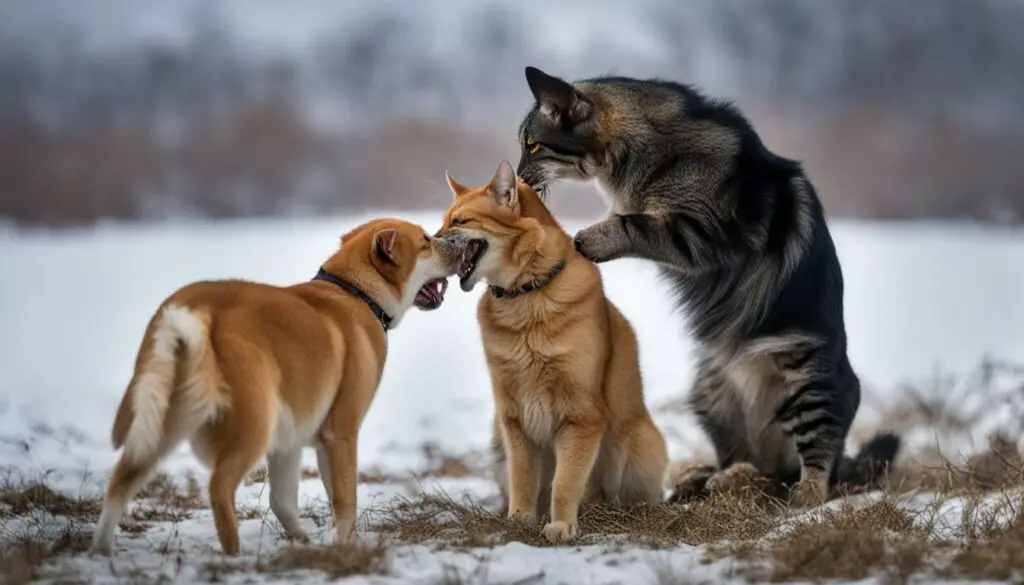
Table: Tips for Managing Territorial Aggression
| Tip | Description |
|---|---|
| Gradual integration | Introduce new pets slowly, allowing them to become familiar with each other’s scents and gradually increasing face-to-face interactions. |
| Create separate spaces | Provide each pet with their own territory, including separate feeding areas, litter boxes, and resting spots. |
| Positive reinforcement | Reward calm and non-aggressive behavior with treats and praise, and encourage positive interactions between the pets. |
| Ensure plentiful resources | Make sure each pet has their own food, water, toys, and scratching posts to reduce competition and triggers for aggression. |
| Seek professional help | If territorial aggression persists, consult with a veterinarian or animal behaviorist for specialized guidance. |
Coping with Aggression Due to Overstimulation
Overstimulation can sometimes lead to aggression in cats, causing them to become overwhelmed and lash out. It’s important to understand how to manage and prevent overstimulation to create a calmer environment for your furry friends.
One way to manage overstimulation is by providing regular play and exercise sessions for your cat. Engaging their natural instincts through interactive toys and playtime can help release pent-up energy and reduce the likelihood of aggression.
Creating a calm and quiet environment can also help prevent overstimulation. Cats are sensitive creatures, so making sure they have a quiet space to retreat to when they feel overwhelmed can be beneficial. Setting up designated areas with cozy beds, hiding spots, and scratching posts can provide a sense of security and help reduce aggression.

Preventing Cat Overstimulation: Key Tips
- Monitor your cat’s behavior for signs of overstimulation, such as dilated pupils, increased arousal, or aggressive body language.
- Establish a routine that includes regular playtime to expend your cat’s energy in a controlled and appropriate manner.
- Introduce new experiences and stimuli gradually to prevent overwhelming your cat.
- Avoid rough play or overhandling that could escalate into aggression.
- Provide mental stimulation through puzzle toys or treat-dispensing toys to keep your cat engaged and prevent boredom.
- Ensure your cat has access to a quiet and safe space where they can retreat when feeling overstimulated.
Remember, every cat is unique, and it may take time to find the right combination of strategies to manage overstimulation and prevent aggression. If your cat’s aggression persists or worsens, it’s important to consult with a veterinarian or animal behaviorist for further guidance and assistance.
Dealing with Predatory Aggression
Cats are natural predators, and their hunting instincts can sometimes lead to aggression towards other pets, including dogs. Understanding and managing predatory aggression is essential for maintaining a harmonious environment in your home. Here are some tips to help you address this issue:
Recognizing Predatory Aggression:
When a cat exhibits predatory aggression, it may display behaviors such as stalking, pouncing, chasing, and biting. These actions are driven by their instinctual desire to hunt and capture prey. In the presence of a dog, the cat may perceive it as potential prey and exhibit aggressive behavior accordingly.
Redirecting Predatory Behavior:
To redirect your cat’s predatory aggression, provide plenty of mental and physical stimulation through interactive toys and play sessions. Engaging your cat in activities that mimic hunting, such as chasing a toy on a string or using puzzle feeders, can help satisfy their natural instincts in a harmless way.
Creating a Safe Space:
Ensure that your cat has a designated safe space where it can retreat when feeling overwhelmed or anxious. This can be a tall cat tree or a separate room equipped with hiding spots, scratching posts, and comfortable resting areas. By providing a secure environment, you can help reduce your cat’s stress levels and minimize predatory aggression.
| Signs of Predatory Aggression: | How to Manage Predatory Aggression: |
|---|---|
| Stalking and chasing behavior towards the dog | Engage your cat in interactive play sessions to redirect their energy. |
| Biting and scratching the dog during play | Teach your cat appropriate play behavior using positive reinforcement techniques. |
| Fixated gaze and dilated pupils when in the presence of the dog | Provide your cat with a safe space where it can observe the dog from a distance. |
By understanding and addressing predatory aggression in your cat, you can help create a peaceful coexistence between your cat and dog. Remember to always prioritize the safety and well-being of both pets, and consult with a veterinarian or animal behaviorist for further guidance if needed.
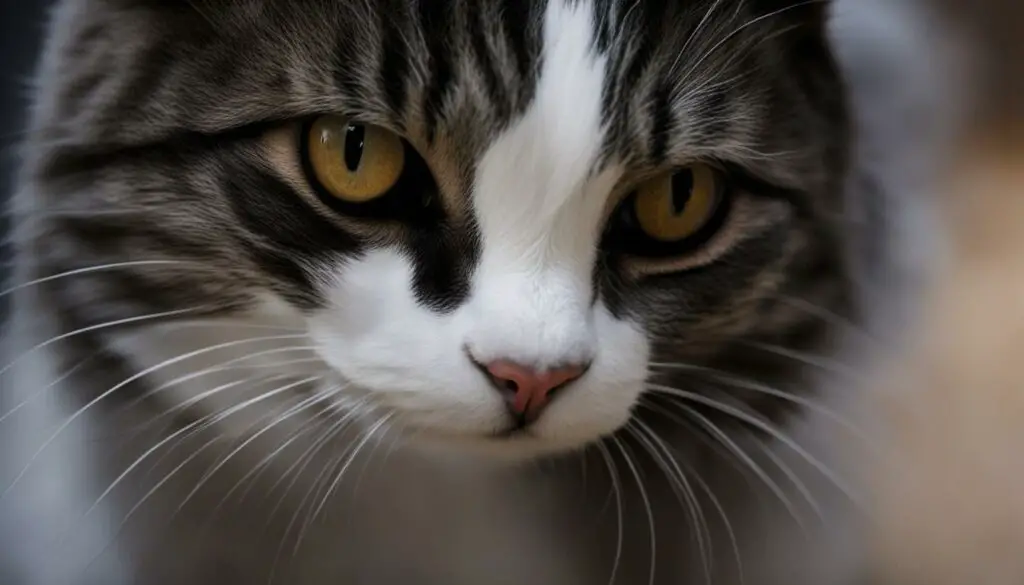
Understanding Unprovoked Aggression
Unprovoked aggression in cats is a rare but concerning behavior that can be challenging to address. It refers to sudden and unexpected acts of aggression without any apparent trigger or provocation. If your cat exhibits unprovoked aggression, it is important to take the necessary steps to understand and address this behavior.
This type of aggression could be a result of underlying medical issues or pain. It is crucial to rule out any medical causes by consulting with a veterinarian. They can conduct a thorough examination and run relevant tests to ensure that your cat’s aggression is not related to an underlying health condition.
Addressing unexplained cat aggression may require the assistance of a professional. A veterinarian or animal behaviorist who specializes in cat behavior can provide valuable insights and guidance specific to your situation. They will work with you to develop a customized behavior modification plan to address the aggression effectively.
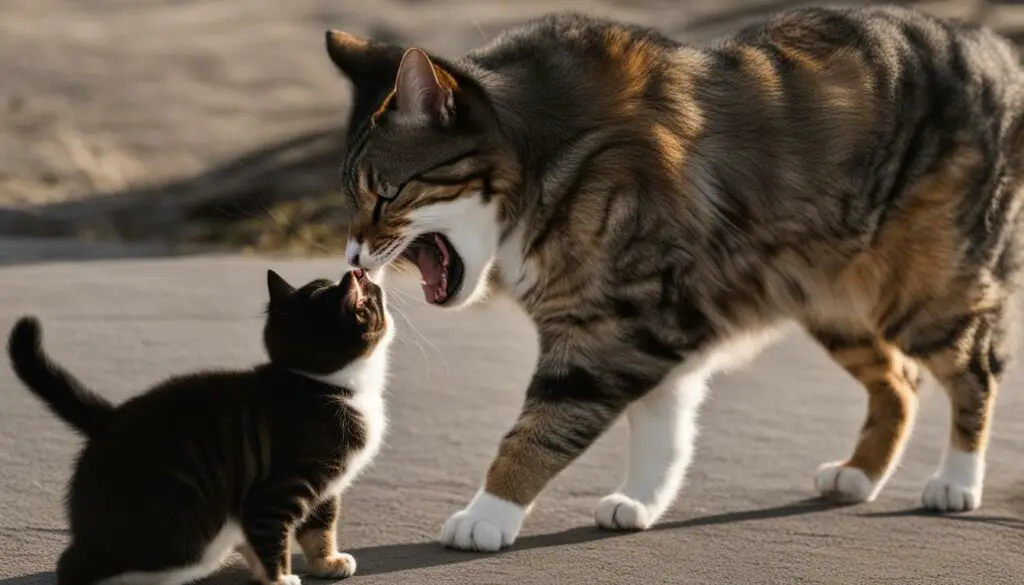
Remember, cats are complex creatures, and their behavior can be influenced by various factors. Patience, consistency, and professional guidance are key in managing and reducing unprovoked aggression in cats. By addressing this behavior early on and seeking appropriate help, you can create a safer and more harmonious environment for both your cat and your dog.
Tips for Managing Cat and Dog Interactions
Introducing a new cat or dog into your household can be an exciting but challenging experience. Ensuring a harmonious relationship between these two species requires careful management and proactive steps. Here are some tips to help you navigate the integration process:
Establish a Gradual Introduction
When bringing a new cat or dog home, it’s important to take things slow. Start by providing each pet with their own space, separated by a pet gate or closed door. This allows them to become familiar with each other’s scents without direct contact. Over time, you can gradually introduce supervised face-to-face interactions, ensuring that both animals feel safe and comfortable.
Create a Safe and Positive Environment
Creating a safe environment for both your cat and dog is crucial. Provide separate feeding areas, litter boxes, and comfortable resting spots for each pet to reduce competition and potential conflicts. Additionally, ensure that each animal has access to their own toys, scratching posts, and hiding places to promote individual stimulation and relaxation.
Use Positive Reinforcement and Rewards
Positive reinforcement is key to helping your cat and dog build positive associations with each other. Reward good behavior with treats, praise, and affection. This will help them understand that calm and friendly interactions are desirable. Avoid punishment or negative reinforcement, as it can create fear and anxiety, leading to increased aggression.
Seek Professional Help if Needed
If you are struggling to manage cat and dog aggression despite your best efforts, it may be beneficial to seek professional help. Consult a veterinarian or animal behaviorist who specializes in cat and dog behavior. They can assess the situation, provide personalized guidance, and develop a behavior modification plan tailored to your pets’ specific needs.
| Tip | Description |
|---|---|
| Tip 1 | Start with gradual introductions |
| Tip 2 | Create separate spaces for each pet |
| Tip 3 | Use positive reinforcement and rewards |
| Tip 4 | Seek professional help if needed |
Creating a Safe Environment for Your Cat
When it comes to managing aggression in cats, creating a safe and stress-free environment is crucial. Providing your cat with designated safe spaces and hiding spots can help alleviate anxiety and reduce the likelihood of aggressive behavior.
Cats are natural climbers, so offering vertical spaces such as cat trees, shelves, or perches can give them a sense of security and allow them to observe their surroundings from a higher vantage point. You can also create cozy hiding spots using cat beds, blankets, or even repurposed cardboard boxes. These hiding spots can serve as retreats for your cat when they feel overwhelmed or need some alone time.
Reducing stress in your cat’s environment is essential for promoting peace and well-being. Consider using pheromone diffusers or sprays, such as Feliway, which can help create a calming atmosphere. Additionally, providing multiple litter boxes, food and water bowls, and scratching posts in different areas of your home can help reduce competition and potential conflict between cats.
Table: Essential Elements for a Cat’s Safe Space
| Element | Description |
|---|---|
| Vertical spaces | Provide cat trees, shelves, or perches for climbing and observing. |
| Hiding spots | Create cozy areas with cat beds or repurposed cardboard boxes for retreat. |
| Calming products | Use pheromone diffusers or sprays to create a calming atmosphere. |
| Multiple resources | Offer multiple litter boxes, food and water bowls, and scratching posts in different areas. |
In addition to providing a safe physical environment, enriching your cat’s surroundings can help prevent boredom and reduce aggression. Interactive toys, puzzle feeders, and scratching posts can engage their natural instincts and redirect their energy. You can also set up window perches or bird feeders outside to provide visual stimulation for your cat.
Remember, cats are individuals with unique preferences and personalities. Take the time to observe your cat’s behavior and adjust their environment accordingly. By creating a safe and enriching space for your cat, you can help promote their overall well-being and reduce the likelihood of aggression.

Steps to Take When Aggression Persists
If despite your best efforts, your cat continues to exhibit persistent aggression towards your dog, it may be necessary to seek professional help. Consulting with a veterinarian or animal behaviorist who specializes in cat behavior can provide valuable insights and guidance specific to your situation. They have the expertise to analyze the root causes of your cat’s aggression and develop a customized behavior modification plan.
Professional help can involve a thorough assessment of your cat’s behavior, including observing their interactions with the dog and identifying any triggers. The veterinarian or animal behaviorist may also recommend additional interventions, such as medication or specific training techniques, to address the aggression effectively.
It is essential to follow the professional’s guidance and instructions diligently. They may provide you with specific strategies to gradually reintroduce the cat and dog, manage their interactions, and create a safe environment for both. Consistency and patience are key during this process, as it may take time for your cat’s behavior to improve.
Remember, seeking professional help shows your commitment to the well-being of your pets and your dedication to resolving the aggression issues. With the right guidance and approach, it is possible to find a resolution and restore harmony between your cat and dog.
Table: Professional Help for Cat Aggression
| Steps | Description |
|---|---|
| Step 1 | Consult with a veterinarian or animal behaviorist who specializes in cat behavior. |
| Step 2 | Thorough assessment of your cat’s behavior to identify triggers and underlying causes. |
| Step 3 | Customized behavior modification plan developed based on the assessment. |
| Step 4 | Recommendations for additional interventions, such as medication or specific training techniques. |
| Step 5 | Follow the professional’s guidance and instructions consistently. |
| Step 6 | Gradual reintroduction of the cat and dog, with managed interactions. |
| Step 7 | Create a safe environment for both pets, implementing strategies recommended by the professional. |
Conclusion
In summary, managing cat aggression towards dogs requires understanding the underlying causes and implementing appropriate strategies. By recognizing the different types of aggression, such as fear aggression, redirected aggression, territorial aggression, overstimulation, predatory aggression, and unprovoked aggression, you can tailor your approach to address the specific behavior.
Creating a safe environment for your cat is essential in minimizing aggression. Providing hiding spots, high perches, and separate feeding areas can reduce stress and promote a sense of security. Environmental enrichment, like interactive toys and scratching posts, can alleviate boredom and redirect their energy towards positive outlets.
When introducing a new cat or dog into your household, take it slow and allow for gradual integration. Supervised face-to-face interactions, positive reinforcement, and creating a safe space for each pet can foster a peaceful coexistence. However, if aggression persists despite your efforts, it may be necessary to consult with a veterinarian or animal behaviorist who specializes in cat behavior to develop a customized behavior modification plan.
Ultimately, with patience, consistency, and professional guidance if needed, you can manage cat aggression and promote peace between your beloved pets. By understanding their unique behaviors and providing a nurturing environment, you can ensure the well-being of both your cat and dog.
FAQ
What are the possible causes of sudden aggression in cats?
Sudden aggression in cats can be caused by various factors, including feeling threatened, territorial disputes, redirected aggression, overstimulation, fear aggression, and underlying medical issues. Cats may also exhibit sudden aggression due to changes in their environment or stress factors.
How can I manage play aggression in my cat?
Play aggression in cats can be managed by establishing boundaries and redirecting their aggression towards appropriate toys or play objects. Gradual desensitization, using noise deterrents, and providing alternative outlets for play can help reduce play aggression in cats.
What can I do to address fear aggression in my cat towards other pets?
To address fear aggression in cats, it is important to avoid situations that trigger fear, gradually desensitize the cat to those triggers, provide a safe space for the cat to retreat to, and use positive reinforcement techniques to reduce fear and aggression towards other pets.
How do I handle redirected aggression in my cat?
Redirected aggression in cats can be handled by identifying and removing the stimuli that trigger the aggression, separating the cat from the trigger, and using noise deterrents. This can help prevent the cat from redirecting its aggression towards another target, such as a dog.
What can I do to manage territorial aggression in my cat?
To manage territorial aggression in cats, it is important to introduce new pets slowly, provide separate spaces for each pet, and ensure that each pet has their own resources. Gradual integration, positive reinforcement, and establishing clear boundaries can help reduce territorial aggression in cats.
How can I prevent overstimulation in my cat and reduce aggression?
Overstimulation in cats can lead to aggression, so it is important to recognize the signs of overstimulation, provide regular play and exercise sessions, and ensure a calm and quiet environment. This can help prevent overstimulation and reduce aggression in cats.
What can I do to address predatory aggression in my cat towards my dog?
To address predatory aggression in cats, it is important to provide mental and physical stimulation through interactive toys, play sessions, and environmental enrichment. This can help satisfy their predatory instincts and reduce aggression towards other pets, including dogs.
Is unprovoked aggression common in cats?
Unprovoked aggression in cats is rare, but it may have underlying medical causes or be a result of pain or discomfort. It is important to rule out any medical issues and consult with a veterinarian if a cat exhibits unexplained aggression.
How can I ensure a peaceful coexistence between my cat and dog?
Introducing a new cat or dog into a household should be done gradually, using crates, pet gates, and closed doors to separate the pets initially. Supervised face-to-face interactions, positive reinforcement, and creating a safe space for each pet can help foster a peaceful coexistence between cats and dogs.
What steps can I take to create a safe environment for my cat?
Creating a safe environment for your cat involves providing hiding spots, high perches, and separate feeding areas. Environmental enrichment, such as interactive toys, scratching posts, and access to outdoor enclosures, can also help alleviate boredom and reduce aggressive behavior in cats.
When should I seek professional help for my cat’s aggression towards my dog?
If despite your efforts, your cat continues to exhibit aggression towards your dog, it may be necessary to seek professional help. Consulting with a veterinarian or animal behaviorist who specializes in cat behavior can provide valuable insights and guidance specific to your situation.
How can I manage cat aggression and ensure the well-being of all my pets?
Understanding the reasons behind your cat’s aggression towards your dog is the first step. By recognizing the different types of aggression, implementing appropriate management strategies, and seeking professional help when needed, you can create a safe and peaceful environment for both your cat and dog. Patience and consistency are key in managing cat aggression and promoting a harmonious relationship between your pets.







